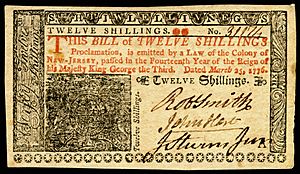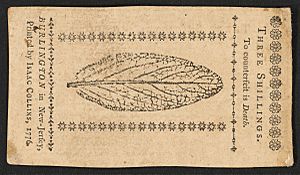New Jersey pound facts for kids
Before the United States had its own money, each colony used different types of currency. In New Jersey, the pound was the main type of money until 1793. At first, people used British money (called sterling coin) and money from other countries. But starting in 1709, New Jersey also began printing its own paper money.
This paper money was called "bills of credit." Even though it was called a "pound," it wasn't worth as much as a British pound.
Contents
Early Money in New Jersey
In the early 1700s, there was a bit of a mix-up with money values across the colonies. To fix this, Queen Anne of England made a rule in 1704. This rule said that a Spanish dollar (a common coin back then) would be worth 6 colonial shillings. This new standard was called "Proclamation Money." It helped make sure that money had a more consistent value everywhere.
Paper Money and Its Value
New Jersey's paper money was known as "bills of credit." These bills were like IOUs from the government. They were considered "legal tender," meaning they had to be accepted for payments.
Each piece of paper money had a note on it saying how much silver it was worth. For example, the first paper money in 1709 was worth 2½ ounces of silver for every New Jersey pound. After 1724, the notes showed their value based on the "Proclamation Money" standard.
Even with these rules, the value of money could change. For instance, a Spanish dollar was officially worth 6 New Jersey shillings. But by the 1750s, people in New York and parts of New Jersey often traded a Spanish dollar for 8 shillings. In Pennsylvania and western New Jersey, it was traded for 7 shillings and 6 pence.
Why New Jersey's Money Was Stable
New Jersey's paper money stayed surprisingly stable in value, even up to the American Revolution. Experts have studied why this happened.
One idea is called the "redemption theory." This theory says that the money was stable because:
- Each set of paper money had a clear date when it would expire.
- The colonial government always paid back its paper money at its full value. They did this using taxes they collected.
For example, when New Jersey needed money to pay for wars like Queen Anne's War or the French and Indian War, they printed paper money. At the same time, they approved taxes that would be collected later. This way, the paper money helped pay for the war, and people used the money to pay their taxes later, which took the money out of circulation.
New Jersey also printed money to lend to its citizens. People could borrow this money to buy land. The land then acted as "collateral," meaning it was a guarantee for the loan. When people paid back their loans, the money was returned to the government, which also helped keep its value stable.
Another idea is that New Jersey's money was stable because it was used alongside real silver and gold coins. Merchants agreed to accept the paper money at a certain rate compared to the Spanish dollar. This made the paper money seem trustworthy, almost like it could be exchanged for metal coins, which helped it keep its value.
Changes After the Revolution
After the American Revolution began, the State of New Jersey started printing "Continental currency." This money was also in pounds and shillings, but it was also linked to the Spanish dollar.
In the mid-1780s, New Jersey also made its own copper coins. These coins had the Latin name for the state, "Nova Cæsarea," on them.
Eventually, the Continental currency lost most of its value. It was later replaced by the new United States dollar. The exchange rate was very high: 1,000 Continental dollars were worth only 1 U.S. dollar.



